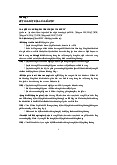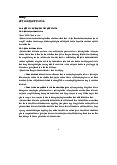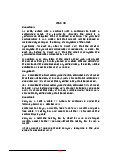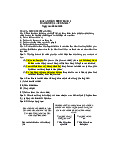











Preview text:
IAS 20 IAS 20
Accounting for Government Grants and
Disclosure of Government Assistance
In April 2001 the International Accounting Standards Board adopted IAS 20 Accounting for
Government Grants and Disclosure of Government Assistance, which had originally been issued
by the International Accounting Standards Committee in April 1983.
Other Standards have made minor consequential amendments to IAS 20. They include
IFRS 13 Fair Value Measurement (issued May 2011), Presentation of Items of Other Comprehensive
Income (Amendments to IAS 1) (issued June 2011), IFRS 9 Financial Instruments (Hedge
Accounting and amendments to IFRS 9, IFRS 7 and IAS 39) (issued November 2013) and
IFRS 9 Financial Instruments (issued July 2014). © IFRS Foundation A1165 IAS 20 CONTENTS from paragraph
INTERNATIONAL ACCOUNTING STANDARD 20
ACCOUNTING FOR GOVERNMENT GRANTS AND
DISCLOSURE OF GOVERNMENT ASSISTANCE SCOPE 1 DEFINITIONS 3 GOVERNMENT GRANTS 7 Non-monetary government grants 23
Presentation of grants related to assets 24
Presentation of grants related to income 29 Repayment of government grants 32 GOVERNMENT ASSISTANCE 34 DISCLOSURE 39 TRANSITIONAL PROVISIONS 40 EFFECTIVE DATE 41
FOR THE BASIS FOR CONCLUSIONS, SEE PART C OF THIS EDITION BASIS FOR CONCLUSIONS A1166 © IFRS Foundation IAS 20
International Accounting Standard 20 Accounting for Government Grants and Disclosure of
Government Assistance (IAS 20) is set out in paragraphs 1–48. All the paragraphs have
equal authority but retain the IASC format of the Standard when it was adopted by the
IASB. IAS 20 should be read in the context of the Basis for Conclusions, the Preface to
IFRS Standards and the Conceptual Framework for Financial Reporting. IAS 8 Accounting
Policies, Changes in Accounting Estimates and Errors provides a basis for selecting and
applying accounting policies in the absence of explicit guidance. © IFRS Foundation A1167 IAS 20
International Accounting Standard 20
Accounting for Government Grants and Disclosure of Government Assistance1 Scope 1
This Standard shall be applied in accounting for, and in the disclosure of,
government grants and in the disclosure of other forms of government assistance. 2
This Standard does not deal with: (a)
the special problems arising in accounting for government grants in
financial statements reflecting the effects of changing prices or in
supplementary information of a similar nature. (b)
government assistance that is provided for an entity in the form of
benefits that are available in determining taxable profit or tax loss, or
are determined or limited on the basis of income tax liability.
Examples of such benefits are income tax holidays, investment tax
credits, accelerated depreciation allowances and reduced income tax rates. (c)
government participation in the ownership of the entity. (d)
government grants covered by IAS 41 Agriculture. Definitions 3
The following terms are used in this Standard with the meanings specified:
Government refers to government, government agencies and similar bodies
whether local, national or international.
Government assistance is action by government designed to provide an
economic benefit specific to an entity or range of entities qualifying under
certain criteria. Government assistance for the purpose of this Standard
does not include benefits provided only indirectly through action affecting
general trading conditions, such as the provision of infrastructure in
development areas or the imposition of trading constraints on competitors.
Government grants are assistance by government in the form of transfers of
resources to an entity in return for past or future compliance with certain
conditions relating to the operating activities of the entity. They exclude
those forms of government assistance which cannot reasonably have a 1
As part of Improvements to IFRSs issued in May 2008 the Board amended terminology used in this
Standard to be consistent with other IFRSs as follows: (a) ‘taxable income’ was amended to
‘taxable profit or tax loss’, (b) ‘recognised as income/expense’ was amended to ‘recognised in
profit or loss’, (c) ‘credited directly to shareholders’ interests/equity’ was amended to ‘recognised
outside profit or loss’, and (d) ‘revision to an accounting estimate’ was amended to ‘change in accounting estimate’. A1168 © IFRS Foundation IAS 20
value placed upon them and transactions with government which cannot
be distinguished from the normal trading transactions of the entity.2
Grants related to assets are government grants whose primary condition is
that an entity qualifying for them should purchase, construct or otherwise
acquire long‑term assets. Subsidiary conditions may also be attached
restricting the type or location of the assets or the periods during which
they are to be acquired or held.
Grants related to income are government grants other than those related to assets.
Forgivable loans are loans which the lender undertakes to waive repayment
of under certain prescribed conditions.
Fair value is the price that would be received to sell an asset or paid to
transfer a liability in an orderly transaction between market participants at
the measurement date. (See IFRS 13 Fair Value Measurement.) 4
Government assistance takes many forms varying both in the nature of the
assistance given and in the conditions which are usually attached to it.
The purpose of the assistance may be to encourage an entity to embark on a
course of action which it would not normally have taken if the assistance was not provided. 5
The receipt of government assistance by an entity may be significant for the
preparation of the financial statements for two reasons. Firstly, if resources
have been transferred, an appropriate method of accounting for the transfer
must be found. Secondly, it is desirable to give an indication of the extent to
which the entity has benefited from such assistance during the reporting
period. This facilitates comparison of an entity’s financial statements with
those of prior periods and with those of other entities. 6
Government grants are sometimes called by other names such as subsidies, subventions, or premiums. Government grants 7
Government grants, including non‑monetary grants at fair value, shall not
be recognised until there is reasonable assurance that: (a)
the entity will comply with the conditions attaching to them; and (b)
the grants will be received. 8
A government grant is not recognised until there is reasonable assurance that
the entity will comply with the conditions attaching to it, and that the grant
will be received. Receipt of a grant does not of itself provide conclusive
evidence that the conditions attaching to the grant have been or will be fulfilled. 2
See also SIC‑10 Government Assistance—No Specific Relation to Operating Activities. © IFRS Foundation A1169 IAS 20 9
The manner in which a grant is received does not affect the accounting
method to be adopted in regard to the grant. Thus a grant is accounted for in
the same manner whether it is received in cash or as a reduction of a liability to the government. 10
A forgivable loan from government is treated as a government grant when
there is reasonable assurance that the entity will meet the terms for forgiveness of the loan. 10A
The benefit of a government loan at a below-market rate of interest is treated
as a government grant. The loan shall be recognised and measured in
accordance with IFRS 9 Financial Instruments. The benefit of the below-market
rate of interest shall be measured as the difference between the initial
carrying value of the loan determined in accordance with IFRS 9 and the
proceeds received. The benefit is accounted for in accordance with this
Standard. The entity shall consider the conditions and obligations that have
been, or must be, met when identifying the costs for which the benefit of the
loan is intended to compensate. 11
Once a government grant is recognised, any related contingent liability or
contingent asset is treated in accordance with IAS 37 Provisions, Contingent
Liabilities and Contingent Assets. 12
Government grants shall be recognised in profit or loss on a systematic
basis over the periods in which the entity recognises as expenses the
related costs for which the grants are intended to compensate. 13
There are two broad approaches to the accounting for government grants: the
capital approach, under which a grant is recognised outside profit or loss, and
the income approach, under which a grant is recognised in profit or loss over one or more periods. 14
Those in support of the capital approach argue as follows: (a)
government grants are a financing device and should be dealt with as
such in the statement of financial position rather than be recognised
in profit or loss to offset the items of expense that they finance.
Because no repayment is expected, such grants should be recognised outside profit or loss. (b)
it is inappropriate to recognise government grants in profit or loss,
because they are not earned but represent an incentive provided by
government without related costs. 15
Arguments in support of the income approach are as follows: (a)
because government grants are receipts from a source other than
shareholders, they should not be recognised directly in equity but
should be recognised in profit or loss in appropriate periods. A1170 © IFRS Foundation IAS 20 (b)
government grants are rarely gratuitous. The entity earns them
through compliance with their conditions and meeting the envisaged
obligations. They should therefore be recognised in profit or loss over
the periods in which the entity recognises as expenses the related costs
for which the grant is intended to compensate. (c)
because income and other taxes are expenses, it is logical to deal also
with government grants, which are an extension of fiscal policies, in profit or loss. 16
It is fundamental to the income approach that government grants should be
recognised in profit or loss on a systematic basis over the periods in which the
entity recognises as expenses the related costs for which the grant is intended
to compensate. Recognition of government grants in profit or loss on a
receipts basis is not in accordance with the accrual accounting assumption
(see IAS 1 Presentation of Financial Statements) and would be acceptable only if no
basis existed for allocating a grant to periods other than the one in which it was received. 17
In most cases the periods over which an entity recognises the costs or
expenses related to a government grant are readily ascertainable. Thus grants
in recognition of specific expenses are recognised in profit or loss in the same
period as the relevant expenses. Similarly, grants related to depreciable assets
are usually recognised in profit or loss over the periods and in the proportions
in which depreciation expense on those assets is recognised. 18
Grants related to non‑depreciable assets may also require the fulfilment of
certain obligations and would then be recognised in profit or loss over the
periods that bear the cost of meeting the obligations. As an example, a grant
of land may be conditional upon the erection of a building on the site and it
may be appropriate to recognise the grant in profit or loss over the life of the building. 19
Grants are sometimes received as part of a package of financial or fiscal aids to
which a number of conditions are attached. In such cases, care is needed in
identifying the conditions giving rise to costs and expenses which determine
the periods over which the grant will be earned. It may be appropriate to
allocate part of a grant on one basis and part on another. 20
A government grant that becomes receivable as compensation for expenses
or losses already incurred or for the purpose of giving immediate financial
support to the entity with no future related costs shall be recognised in
profit or loss of the period in which it becomes receivable. 21
In some circumstances, a government grant may be awarded for the purpose
of giving immediate financial support to an entity rather than as an incentive
to undertake specific expenditures. Such grants may be confined to a
particular entity and may not be available to a whole class of beneficiaries.
These circumstances may warrant recognising a grant in profit or loss of the
period in which the entity qualifies to receive it, with disclosure to ensure that
its effect is clearly understood. © IFRS Foundation A1171 IAS 20 22
A government grant may become receivable by an entity as compensation for
expenses or losses incurred in a previous period. Such a grant is recognised in
profit or loss of the period in which it becomes receivable, with disclosure to
ensure that its effect is clearly understood.
Non‑monetary government grants 23
A government grant may take the form of a transfer of a non‑monetary asset,
such as land or other resources, for the use of the entity. In these
circumstances it is usual to assess the fair value of the non‑monetary asset
and to account for both grant and asset at that fair value. An alternative
course that is sometimes followed is to record both asset and grant at a nominal amount.
Presentation of grants related to assets 24
Government grants related to assets, including non‑monetary grants at fair
value, shall be presented in the statement of financial position either by
setting up the grant as deferred income or by deducting the grant in
arriving at the carrying amount of the asset. 25
Two methods of presentation in financial statements of grants (or the
appropriate portions of grants) related to assets are regarded as acceptable alternatives. 26
One method recognises the grant as deferred income that is recognised in
profit or loss on a systematic basis over the useful life of the asset. 27
The other method deducts the grant in calculating the carrying amount of the
asset. The grant is recognised in profit or loss over the life of a depreciable
asset as a reduced depreciation expense. 28
The purchase of assets and the receipt of related grants can cause major
movements in the cash flow of an entity. For this reason and in order to show
the gross investment in assets, such movements are often disclosed as separate
items in the statement of cash flows regardless of whether or not the grant is
deducted from the related asset for presentation purposes in the statement of financial position.
Presentation of grants related to income 29
Grants related to income are presented as part of profit or loss, either
separately or under a general heading such as ‘Other income’; alternatively,
they are deducted in reporting the related expense. 29A [Deleted] 30
Supporters of the first method claim that it is inappropriate to net income and
expense items and that separation of the grant from the expense facilitates
comparison with other expenses not affected by a grant. For the second
method it is argued that the expenses might well not have been incurred by
the entity if the grant had not been available and presentation of the expense
without offsetting the grant may therefore be misleading. A1172 © IFRS Foundation IAS 20 31
Both methods are regarded as acceptable for the presentation of grants related
to income. Disclosure of the grant may be necessary for a proper
understanding of the financial statements. Disclosure of the effect of the
grants on any item of income or expense which is required to be separately
disclosed is usually appropriate. Repayment of government grants 32
A government grant that becomes repayable shall be accounted for as a
change in accounting estimate (see IAS 8 Accounting Policies, Changes in
Accounting Estimates and Errors). Repayment of a grant related to income
shall be applied first against any unamortised deferred credit recognised in
respect of the grant. To the extent that the repayment exceeds any such
deferred credit, or when no deferred credit exists, the repayment shall be
recognised immediately in profit or loss. Repayment of a grant related to
an asset shall be recognised by increasing the carrying amount of the asset
or reducing the deferred income balance by the amount repayable.
The cumulative additional depreciation that would have been recognised in
profit or loss to date in the absence of the grant shall be recognised
immediately in profit or loss. 33
Circumstances giving rise to repayment of a grant related to an asset may
require consideration to be given to the possible impairment of the new carrying amount of the asset. Government assistance 34
Excluded from the definition of government grants in paragraph 3 are certain
forms of government assistance which cannot reasonably have a value placed
upon them and transactions with government which cannot be distinguished
from the normal trading transactions of the entity. 35
Examples of assistance that cannot reasonably have a value placed upon them
are free technical or marketing advice and the provision of guarantees. An
example of assistance that cannot be distinguished from the normal trading
transactions of the entity is a government procurement policy that is
responsible for a portion of the entity’s sales. The existence of the benefit
might be unquestioned but any attempt to segregate the trading activities
from government assistance could well be arbitrary. 36
The significance of the benefit in the above examples may be such that
disclosure of the nature, extent and duration of the assistance is necessary in
order that the financial statements may not be misleading. 37 [Deleted] 38
In this Standard, government assistance does not include the provision of
infrastructure by improvement to the general transport and communication
network and the supply of improved facilities such as irrigation or water
reticulation which is available on an ongoing indeterminate basis for the
benefit of an entire local community. © IFRS Foundation A1173 IAS 20 Disclosure 39
The following matters shall be disclosed: (a)
the accounting policy adopted for government grants, including the
methods of presentation adopted in the financial statements; (b)
the nature and extent of government grants recognised in the
financial statements and an indication of other forms of
government assistance from which the entity has directly benefited; and (c)
unfulfilled conditions and other contingencies attaching to
government assistance that has been recognised. Transitional provisions 40
An entity adopting the Standard for the first time shall: (a)
comply with the disclosure requirements, where appropriate; and (b) either: (i)
adjust its financial statements for the change in accounting
policy in accordance with IAS 8; or (ii)
apply the accounting provisions of the Standard only to
grants or portions of grants becoming receivable or
repayable after the effective date of the Standard. Effective date 41
This Standard becomes operative for financial statements covering periods
beginning on or after 1 January 1984. 42
IAS 1 (as revised in 2007) amended the terminology used throughout IFRSs. In
addition it added paragraph 29A. An entity shall apply those amendments for
annual periods beginning on or after 1 January 2009. If an entity
applies IAS 1 (revised 2007) for an earlier period, the amendments shall be
applied for that earlier period. 43
Paragraph 37 was deleted and paragraph 10A added by Improvements to IFRSs
issued in May 2008. An entity shall apply those amendments prospectively to
government loans received in periods beginning on or after 1 January 2009.
Earlier application is permitted. If an entity applies the amendments for an
earlier period it shall disclose that fact. 44 [Deleted] 45
IFRS 13, issued in May 2011, amended the definition of fair value in
paragraph 3. An entity shall apply that amendment when it applies IFRS 13. 46
Presentation of Items of Other Comprehensive Income (Amendments to IAS 1), issued
in June 2011, amended paragraph 29 and deleted paragraph 29A. An entity
shall apply those amendments when it applies IAS 1 as amended in June 2011. A1174 © IFRS Foundation IAS 20 47 [Deleted] 48
IFRS 9, as issued in July 2014, amended paragraph 10A and deleted
paragraphs 44 and 47. An entity shall apply those amendments when it applies IFRS 9. © IFRS Foundation A1175




